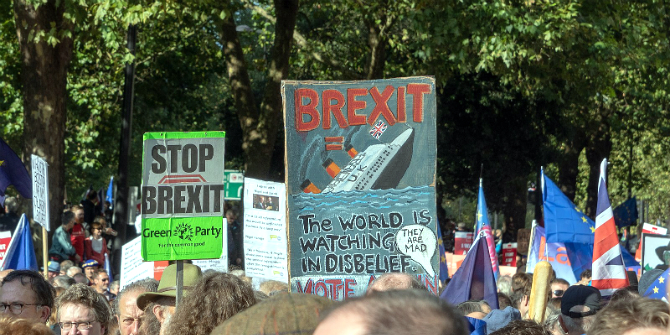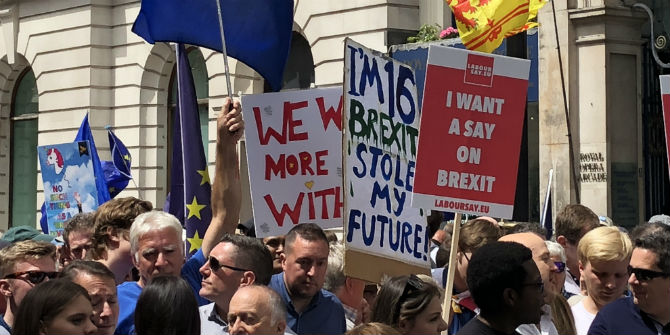 With deadlock in Westminster and both parties bitterly divided on Europe, it may be the case that the only way out of the Brexit impasse is another vote in which May’s deal is put to the people. At present, however, there is no majority in Parliament for such a referendum, writes John Ryan (LSE). This, though, may change very soon, he argues.
With deadlock in Westminster and both parties bitterly divided on Europe, it may be the case that the only way out of the Brexit impasse is another vote in which May’s deal is put to the people. At present, however, there is no majority in Parliament for such a referendum, writes John Ryan (LSE). This, though, may change very soon, he argues.
Brexiteers argue that to hold a second EU referendum would show disrespect to those who voted by 52% to 48% for Brexit. Yet it was UKIP leader Nigel Farage who told the Daily Mirror on 16 May 2016 – 38 days before the referendum – that “in a 52-48 referendum [result to remain in the EU] this would be unfinished business by a long way”. The BBC quoted him as saying that “there could be an unstoppable demand for a rerun of the EU referendum if Remain wins by a narrow margin”. “Win or lose this battle,” Farage declared, “we will win this war.”
With deadlock in Parliament, both main parties so deeply divided on Europe, it may start to appear that the only way out of the impasse is a second referendum in which the government’s deal is put to the people for legitimation.
Prime Minister Theresa May is said to be opposed to a second referendum as it would split the Conservative party very badly. Meanwhile, Labour MPs Peter Kyle and Phil Wilson have put forward an amendment which would offer all MPs the chance to support, or abstain on, the withdrawal bill and would specify that, if passed, the decision would be implemented on the condition it was put to the public for approval in a second referendum. If the amendment passed through Parliament but the deal was rejected in the subsequent referendum, the UK would stay in the EU under current arrangements. If, however, the British people confirmed the decision of MPs to leave the EU under the terms of May’s deal, Brexit on these terms would immediately come into effect without any need for it to return to Parliament.
Labour’s support for a new referendum is a necessary condition to get one. Party leader Jeremy Corbyn may have taken this course of action because he wants to stop more Labour MPs defecting to The Independent Group. One of the attractions of the Kyle-Wilson amendment is that it could help build the necessary coalition in the Commons. Some Labour MPs in “Leave” constituencies are reluctant to back a straightforward People’s Vote because they think it involves voting against Brexit. But supporting the Kyle-Wilson amendment, allows them to say they are not opposing Brexit.
Some Tory MPs may find this appealing too. They can say that, while they back the prime minister’s deal, there’s no majority for it in the Commons. Given that they do not want to crash out with no deal at all, the only option is to put it to the people.
On BBC Question Time recently, Shadow International Trade Secretary Barry Gardiner said that while he believed a second referendum “is the only way that we have to stop no deal”, he still thinks that a referendum does “undermine trust in democracy”. If faced with a choice between Theresa May’s (expected) deal and Remain, he would opt to stay in the EU.

For the UK to hold a second referendum, the EU27 would need to agree in unison to extend the Article 50 deadline beyond 29 March 2019. There is a view that the EU27 would in fact only grant an extension if Britain has some kind of plan to end the deadlock such as a general election, or a second referendum. For the former to be triggered, the government would have to come under political pressure to resign through a vote of no confidence in the Commons – or to move a motion for an early general election under the Fixed-term Parliaments Act 2011. A Bill would be required to be debated and agreed by both House of Commons and House of Lords – and passed into law as an Act – exactly as happened with the European Union Referendum Act 2015 – the Act that led to the Brexit referendum in June 2016.
There is no set time as to how long a period is needed for a Bill to pass through Parliament. It depends on the length and complexity of the Bill, how many amendments are tabled, whether it has broad cross-party support or whether it is controversial. With regards to a second referendum, UCL’s Constitution Unit published a report in October 2018 which estimated that it would take 22 weeks between the decision to hold another referendum and polling day. This was made up of 12 weeks to pass the legislation and prepare for the poll and then the 10-week regulated period of the campaign.
The Electoral Commission has a statutory duty set out in the Political Parties, Elections and Referendums Act 2000 (PPERA) to assess any referendum question proposed in legislation for its ‘intelligibility’: are the options clear, simple and neutral? There is a minimum campaign period for referendums held under the framework set out in PPERA. This must be 10 weeks – and it comprises three stages. The first four weeks is the period for registered campaigners to apply to be the lead campaign groups. The next two weeks are the period in which the Commission assesses applications to be lead campaign groups for each possible outcome and designates those groups. In the final four weeks, the designated lead campaigns can utilise the benefits of designation – which include a grant of up to £600,000 and higher spending limits than other registered campaigners.
Given the question to leave has already been answered, a reasonable question would be: Do you prefer to leave with the Prime Minister’s deal or without the Prime Minister’s deal? However, proponents of a second referendum may also seek a route to block Brexit.
Suggestions for the question of a second referendum vary, and have included the following:
- A single two-way vote between the Brexit Deal and Remain
- A single two-way vote between No Deal and Remain
- A single two-way vote between accepting and rejecting the Deal
- A single three-way vote between the Deal, No Deal, and Remain – taking second preferences into account
- A two-stage vote, the first asking Remain vs Leave, the second (if Leave wins) asking Deal vs No Deal
All of these options have their own drawbacks, and there is no consensus as to which should be pursued. Three-way referendums are very unusual, and two-stage referendums could lead to differential turnout problems, undermining democratic legitimacy.
Given the need for an extension of Article 50 to allow time for a referendum to take place, if granted this would almost certainly mean the UK remaining an EU member during the European Parliament elections on 23-26 May. The upshot of this is that the UK would remain bound by its treaty obligations as a member state, including the right of its citizens to participate in European Parliament elections, and thus could be subject to a legal challenge if it did not hold such an election.
But if the EU really wanted to extend British membership by several months, there could be ways around the European Parliament problem; for example, the UK could appoint MPs as MEPs on an interim basis. Even if the “EP challenge” can be fudged, there is yet more complexity. If it is still a member state, the UK would be able to exert influence over the selection of the successors of Commission president Jean-Claude Juncker and Council chairman Donald Tusk. At some point, the British would even gain a say on the EU’s long term budget. That would be a lot of leverage for the UK to use to shape the withdrawal agreement. Is this what the EU27 would want?
The choices and challenges around a possible second referendum are clearly highly complex and questionable in their practicality. The deadlock in the recent votes in Parliament has indicated that there is no majority in Parliament for a second referendum as of now. That may change as there is no majority for any other resolution to unblock the deadlock either while the clock is counting down to the exit date on 29 March.
If Parliament is unable to break the current Brexit deadlock, the decision may have to be passed back to the voters. Even if Parliament does make a choice of a preferred version of Brexit, the implications of that choice need to be clearly spelled out to voters and should be ratified in a referendum to give people some confidence that the politicians will fulfil their promises. The decisions in principle should be made before the end of March: an extension to the Article 50 process will then be needed to accommodate the referendum.
For a second referendum to be held, many hurdles would have to be overcome. There is also no guarantee, that a second referendum would bring the hoped-for clarity for the future status of the UK with the EU. It is in the hands of the government and Parliament to determine next steps.
This article gives the views of the author, and not the position of LSE Brexit, nor of the London School of Economics. Image used © User:Colin / Wikimedia Commons /
Professor John Ryan is a Visiting Fellow at LSE IDEAS. He has been a researcher at CESifo, Munich, Germany, St Edmund’s College, University of Cambridge and the German Institute for International and Security Affairs, Berlin, Germany. John is working as a senior partner in consultancy as a Brexit adviser for EU, Gulf and Asian clients.






